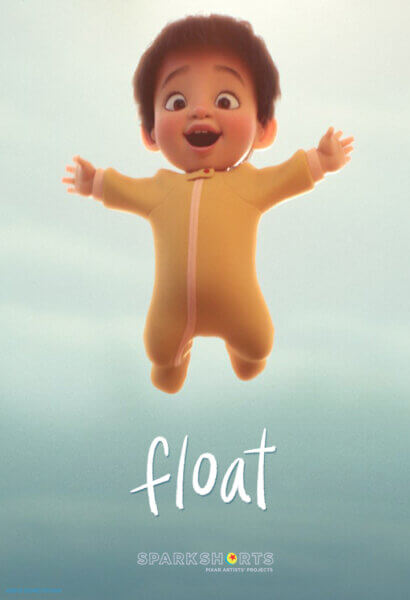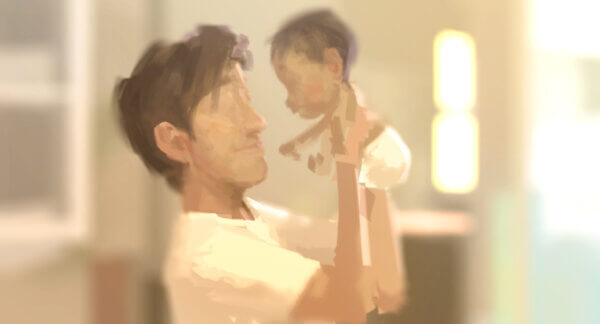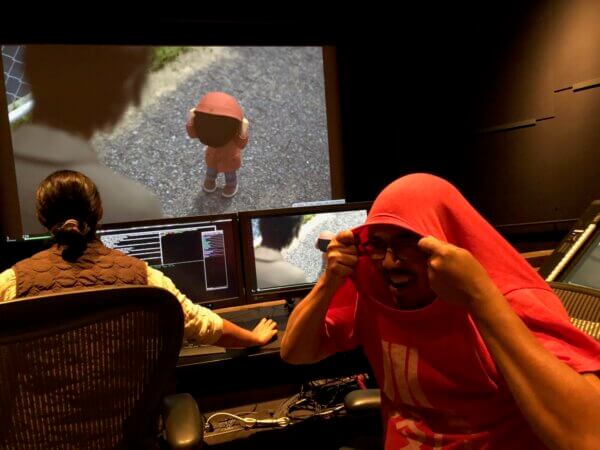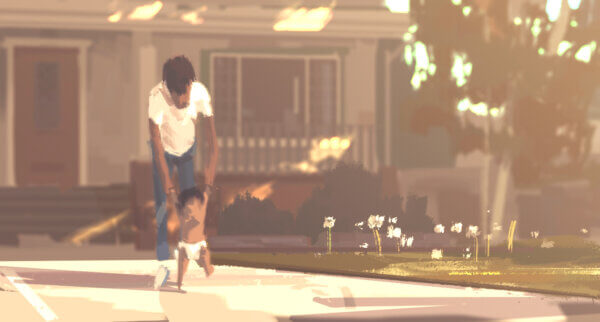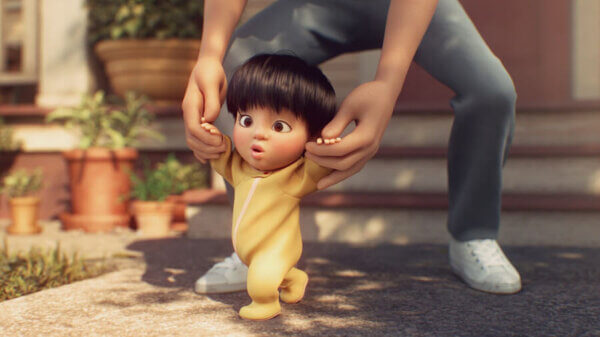Autism Awareness Month: Pixar’s Float – Interview with Bobby Rubio (Director) & Krissy Cababa (Producer)
April is a very important time of year for many autistic individuals and their families as it is also known as Autism Awareness Month. We are celebrating and raising awareness with a series of interviews with producers, writers and directors who have created animated content around this subject.
As both a writer for Skwigly and a proud autistic person myself, I want to thank everyone involved who has made it possible to share these amazing behind the scenes stories and what they have learned on productions that have become important to them. Here I speak with Bobby Rubio (Director) and Krissy Cababa (Producer) about their Pixar SparkShorts film Float; a short that focuses on a son’s ability to fly and the choice his father must make.
(This interview references another Pixar short film with another autistic character at its heart – click here to read our ‘Loop’ interview with Erica Milsom.)
How did you both start your careers at Pixar? And how did you both get involved in the SparkShorts program?
Krissy: So I kind of came to Pixar, I would say accidentally. I didn’t go to film school. It was not my career goal to be in animation or in film and I ended up at Pixar just as a temp and ended up temping doing contract work at Pixar for over a year and then I got hired full time. So I just sort of fell into it, but I discovered that I loved the work and I loved the people. I’m really proud of the work we do and so now I’ve been here for fifteen years and that’s how I got started at Pixar. As for the how we got started on the SparkShorts, well, Bobby can tell you his journey. But basically, we sort of got paired together by Lindsey Collins, who was the executive producer of the SparkShorts at the time and I was really excited about it because I never worked with Bobby before this and I was really, really excited about the project when I saw his pitch and I’m really happy we ended up together.
Bobby: Wow. What’s your first film, Krissy?
Krissy: My first feature was Toy Story 3. So before Toy Story 3, I worked on a bunch of short projects, like the DVD short for Ratatouille. I did some work in development. I worked in facilities. I worked in image mastering with the DVD group. I kind of worked in a lot of different areas of the studio before I got into production. I did some assistant work, you know, so I was kind of all over the place.
So Bobby, how did you start your career at Pixar? How did you get involved the SparkShorts program?
Bobby: It’s crazy. Yeah, it is kind of crazy that we hadn’t worked on the same projects until then. I grew up drawing all my life. Started as a little kid and I just doodled all the time. My Mom saw that I had the talent. I wanted to be a comic book artist. And originally, I wanted to take that in college, to be a comic book artist. There was a school in New York that I wanted to attend, but my mother said “No, you’re staying in California.” So I opted to go to California Institute of the Arts, which is the school that Walt Disney founded, and I took animation there. I graduated with a Bachelor of Fine Arts in 1994 (shows my age) and from there, I went to Walt Disney Feature Animation.
I started in an internship but I eventually started working for the studio on Pocahontas. I wanted to be an animator and I worked my way to finally be an animator on Treasure Planet. And then traditional animation kind of went away, so I had to find a new path. And not only that, Disney let me go so I had to find a new path and I landed at Nickelodeon on Avatar: The Last Airbender. I was a storyboard artists there and then an opportunity came at Pixar for storyboard artists. I tried out for Ratatouille and I did not get it. So I tried a second time and I made it and I got into my first movie, which was Up. The funny thing is my kids got a baby credit on Wall-E; they got credit before I ever did. So a little bit of Pixar trivia.
Originally, I had thought it was gonna be a comic book. I wanted to do it as a comic, based off of my relationship with my son Alex, who is on the autism spectrum. It was such a heavy and difficult kind of story for me to process. So I had to put it aside eight years ago and then I came back to it in 2018. As we talked about it, I did some storyboards. I had thought I would make it a short this time and I showed it around to my friends and colleagues at Pixar and they were like, ‘You should show this to Lindsey Collins, the producer of the SparkShorts.’ So I did and she thought it was great and it was the perfect story to go into the program. And that’s where I was introduced to Krissy and we were teamed up to create this short and yeah, the rest is history.
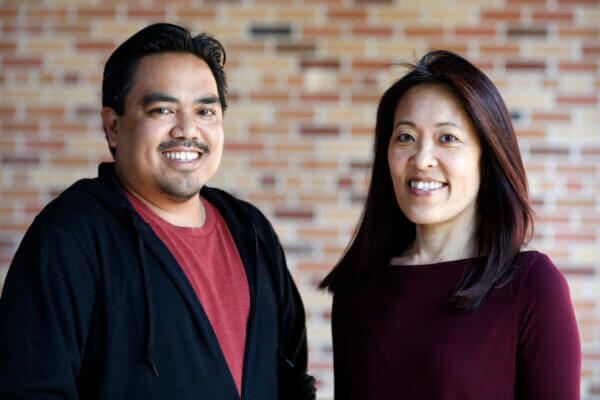
Krissy Cababa and Bobby Rubio, who are producing and directing the Pixar Spark film short called Float, is photographed on August 20, 2018 at Pixar Animation Studios in Emeryville, Calif. (Credit: Photo by Deborah Coleman / Pixar)
Krissy, because you’re a producer on both Float and Loop, what was it about both these two productions that appealed to you?
Krissy: I think first of all, in both cases, it was just kind of coincidental that both Bobby and Erica were telling a story that was related to autism. It was completely unplanned. You know, Bobby’s story comes from his personal story and I really loved that. He was really digging deep into his personal history and to tell this story that has a lot of pain in it and a lot of real learning but then ends up in such a great place.
Erica came at her story from a completely different place, you know, wanting to tell a story about connection and learning to communicate with someone who thinks differently than you do. And Erica, unlike Bobby, who I met as we started to work on Float together, I had known Erica for years before we worked on Loop. One of my earlier jobs at Pixar was with the DVD documentary crew and that’s Erica’s main job. She’s a director on that team and so I knew her for years. I had also produced one of her independent documentaries that that we did called Snow Day and so I had worked with her on that. There was a familiar and non-familiar. I also really loved the way that Erica tells stories and her passion and her drive and so they were both really fantastic stories and I love that they were coming at it from such different angles.
Bobby, as a story artist at Pixar, what was it like to transition into the director’s chair?
Bobby: Completely wonderful and scary at the same time, because I didn’t know the pipeline. I was eager to learn it and I am grateful that I had Krissy with me because Krissy helped me understand the pipeline. I didn’t know what post production and all that did, because I’m usually part of the guys that start the film. I didn’t know what it was like for animation afterwards or lighting and music and all post production stuff. And so I even remember there’s a time when, during layout, and I had to pull Krissy aside, and I was like, “Is it gonna really look like this?” It’s hard to wrap your mind around it because in layout, the characters do not look like the characters. It’s just there for positioning and to get the feel of the film. And I just had to wrap my mind around it that it’s gonna get better.
It’s just another part of the process and I had to get my mind wrapped around it. I was just so used to being a storyboard artist, where I only focus on drawing the characters and making sure that the story is comprehensive. But now you have to think the bigger picture and it’s a wider scope that you are responsible for. And again, I’m grateful that I had Krissy there to walk me through it.
And Krissy when you were producing these shorts, what did you learn the most when it came to supporting both Bobby and Erica and their focus on difference and autism?
Krissy: I think with Erica, we spent a lot of time actually learning about autism itself. I had no prior personal experience with autism before that. So for me, there was a big learning curve on what does it mean? And how do people think? What are the different ways that people express this? And how can we be respectful because we were portraying an actual, autistic nonverbal person, we wanted to make sure that portrayal was respectful and true. I think that also the challenge we had was a mixture, making sure it was comprehensible to a neurotypical audience. So we have that challenge with Loop.
There was a lot of discussion about that on Loop than with Float, because it was coming from Bobby’s personal experience and Bobby chose to use a metaphor of floating for the difference. There wasn’t necessarily as much of digging into that aspect of autism, it was more that Bobby was like ‘how can we make this story the most emotional story that we can make it?’ Are these moments reading? What moments do we need to have between the Father and the Son before this outburst that leads to a positive result at the end? How do we make that story flow the best? How can we make it the most economical?’ I think there was a lot of concentration on that part of it with Float and so they were both very different processes, which I also really enjoyed.
Bobby: I also want to point out one of the contributions that Krissy did for Float storywise is there was a moment where the Father is looking around for his Son in the original boards – he’s looking across the street and down the street level – and Krissy said “He’s floating. He should be looking up.” And, and I was like, “That is brilliant. We are doing that.” So I wanted to say that Krissy also helped out in the story process very much.
The film is based on your personal life and this experience with your son. Could you explain to our readers why you wanted to use this as a source for your first film?
Bobby: If I’m being honest, it was one that Lindsey Collins wanted me to do. But beyond that, I did really want to do Float because this story was gnawing at me for eight years now and I knew I had to get this story out of me. I’m glad that it was shown to the world because actually, Krissy and I, we didn’t know if this was ever going to be out in the world. We thought it was going to be in-house and so there was a part of me that was like, well, it’s only in house and if I’m going to tell a story, I want it to come from my heart and I want to showcase what I can do. And if this was my chance at Pixar to do something amazing, why not say something that really was important to me, which is about autism and my son.
Since we were allowed to make the characters Filipino American, that made it even extra special because now we were the first Filipino American lead characters in a Pixar film and to show representation throughout the world. It’s a big responsibility, but you know, I wasn’t thinking about it at the time.
But now that the world has seen it, I am so proud of this film and what it’s accomplished and the legacy that it will continue to have. It’s funny how you go in about things, just thinking it’s just gonna be a little thing that your friends are going to see, but then it goes out in the world and becomes this huge thing and I am overwhelmed by the response and the love and support we’ve gotten throughout the whole entire world.
Krissy, it seemed that both Bobby and Erica had very different approaches. What was it like to see them approach these subjects within their creative processes? Especially with the way the different relationships developed between the characters in both films?
Krissy: Well, I think at heart we’re all storytellers at Pixar and honestly. There are a lot of similarities between the way that Erica approached her story and Bobby approached his story. I think the elements of a good story are, I wouldn’t say universal, but there are some commonalities. You do want to have a point of crisis, you do want to have something that changes, you want to have something that’s your work. Where you are at the beginning is not where you want to be at the end of the story. I think that there was a lot in both projects. There were many, many conversations about structure, about humour, about timing.
I think Erica comes at her stories from a director standpoint and an editor standpoint, because that’s kind of her background. She directs documentaries and nonfiction for Pixar and so she brought a lot of that sensibility to her choices. And Bobby comes from it from a story point of view so he’s looking at slightly different, but also related elements of the story, They’re both looking at framing, they’re both looking at timing, you’re both looking at how long has it been since we’ve seen this other character? Do we need a point of view here? And so there’s a lot of similarities in the way they approached the actual storytelling of the shorts.
I think where it was different was that the subject matter was so different. For Erica, it was making sure to include autistic people in the consultation of her story and the talent of her story was really, really important and so that took a lot of focus. For Bobby, we spent a lot of time crafting the images like, how is this thing going to look? And we spent a lot of time designing the characters. We wanted them to look Filipino. So how do we change those characters to look Filipino? How do we design this house in this neighbourhood to be what we need it to be for the film when we add the playground and a street and all that. And because we’re in the SparkShorts program, a lot of that stuff was kind of reused or repurposed from other Pixar films. So we just had to kind of squeeze it all in there and make it all work.
In general, there are more similarities to how the films were working. They’re very different people and have different personalities. The stories were different and it was a lot of fun to be working on both.
What was the hardest scene for you to work on and how did you overcome this or these obstacles?
Bobby: Definitely the hardest scene was when the Father yells at this Son, because that’s a very emotional scene. I voiced the father as well and so it was great because we had Krissy and Greg Amundson, our editor, and James Brown, our animation supervisor, in the booth listening to me belt out “Why can’t you be normal?” And it’s very emotional because they were like, “You know, it’s not enough. It’s not strong enough, this voice is gonna have to sell it .” And so we did one hundred takes, Krissy, for that one?
Krissy: It was a lot.
Bobby: But that line had to be perfect. I remember Greg, James and Krissy felt like that’s the moment. That’s the main moment in this short and that has to ring true and authentic and if that didn’t ring true and authentic, people are going to laugh at that moment or they’re not going to feel it. And so that moment was very tough to do. But yeah, we came through and then it’s resonated with most people.
Krissy: Yeah, that was a tough moment. We spend a lot of time talking with the crew about that moment because having a parent screaming at their kid, that is not something that you would normally expect in a Pixar short or a Pixar film. We had a lot of, like, ‘is this the right thing? Are we doing the right thing? Do we need to tone it down a little bit?’
I remember Bobby, we had that conversation, like, ‘do we need to tone this down?’ And in the end, we decided that no, it was a really important moment and, talking to the parents in the room, every parent has a story about a time they just lost it with their kid. You regret it instantly. The words are out of your mouth, but it’s just this thing that happens. It felt true, and it felt real and we all felt that we couldn’t get the victory later when he decides to stay in the park and join this kid on the swing without that moment of yelling and so that was a really tough one. As Bobby said, the voice performance was really important, but that whole moment was one we spent a lot of time on.
Bobby: We even considered not even having the voice. Like he’s yelling, but you don’t actually hear the dialogue. But we thought let’s just go for it. Let’s go full on and hammer it home. And I think it does make the film stronger because it’s there.

The Spark project, Float, directed by Bobby Rubio and produced by Krissy Cababa, with their production team, as seen on August 20, 2018 at Pixar Animation Studios in Emeryville, Calif. (Credit: Photo by Deborah Coleman / Pixar)
What has the reception been like since the film’s debut on Disney+ and on YouTube?
Bobby: It’s been super amazing and wonderful, especially for YouTube, I think we’re coming up on 50 million views. But since it’s on YouTube, you get to see people’s reactions typed in and you see the actual numbers. Not only that, I’ve received plenty of notes from people all across the world and that just amazes me, too. I’ve received messages from Turkey, from France; just globally, and it is overwhelming. It’s been overwhelmingly positive. So it’s nice that something we’ve created has touched people’s lives and have brought about healing all across the world. And now I can actually say that because there’s proof versus me going like, you know, I think it did.
Krissy: I think what’s been really nice is that people are reacting on many different levels. So there’s an element of the Filipino American community and they’re just really excited to see themselves on the screen because that’s just such a different and new thing. So there’s that whole bit.
And then because of the way Bobby chose to tell his story, as you know, floating being a metaphor for difference, I think that pulls in a lot of people who see themselves or see their kids in that story, even if it’s not a child who is on the spectrum. It could be a child who has any other kind of difference or yourself who has any kind of difference that you’ve been made fun of in the past or felt ostracised in the past. So I think there’s a bit of universality to the story which has been really gratifying. I really do think that Float is about learning to love your family for who they are and not necessarily for who you want them to be and about acceptance. That’s something that in this day and age, I really do think is an important message and I hope that’s doing a little bit of good out in the world.


